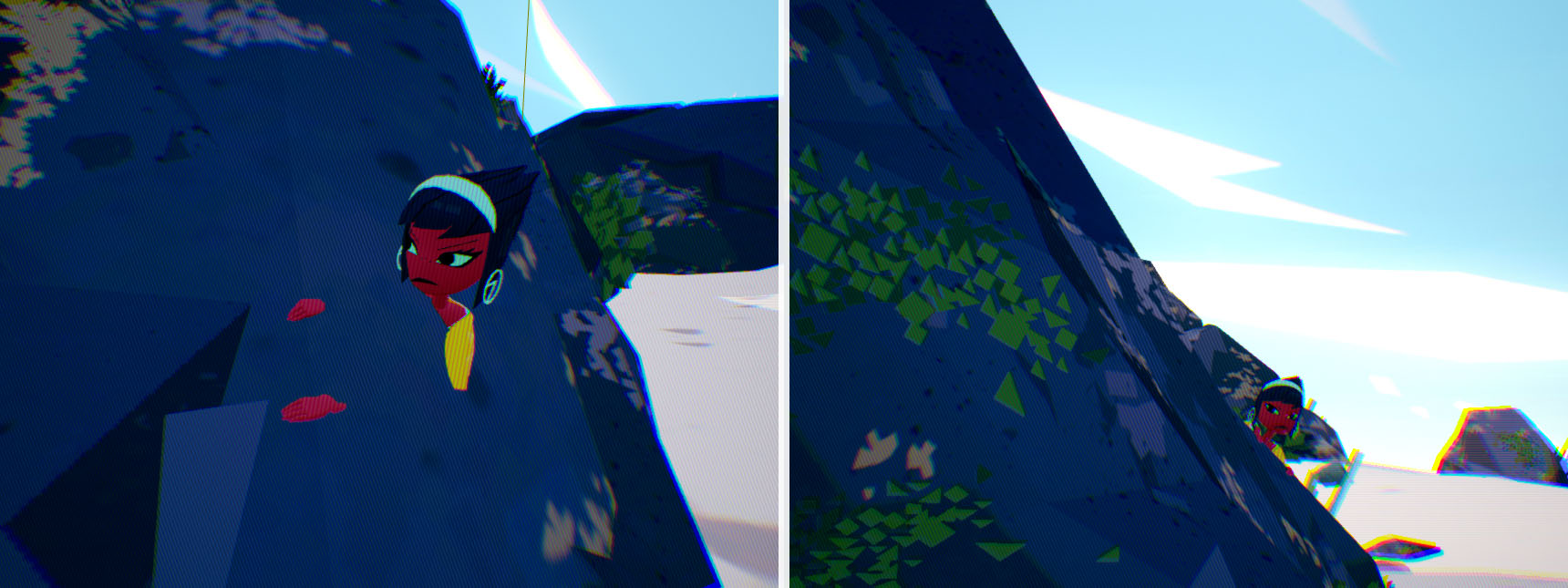Case Study5E
© COPYRIGHT MMXXI CHROMOSPHERE. ALL RIGHTS RESERVED.

2D/3D HYBRID ANIMATION / 2021
CASE STUDY NAVIGATION:
PART 1: Origins / PART 2: A New Pipeline / PART 3: Designing for Unreal / PART 4: Layout / PART 5: Rigging & Animation / PART 6: The Look / PART 7: Effects & Conclusion
RIGGING
Unlike many other more typical CG productions, the characters in Yuki were designed to look imperfect when they moved. The blocky joints and floating eyes & mouths give them a unique paper sculpture feeling, which we wanted to make sure we could maintain when moving to the Unreal pipeline. Our rigging artist, Lauren Hammond, helped to ensure the rigs translated properly and that all of the new characters could also be nice and chunky in their movements.
^ YUKI SHIRT RIG TEST BY LAUREN HAMMOND
LAUREN HAMMOND (Rigger / Animator): In general, the style of the rigs for Yuki 7 are not terribly complicated because of the low-poly effect that we were going for. So the main thing that needed to change with switching to Unreal was getting rid of any time that I had used a Maya-specific deformer inside of the rig. Those needed to be re-designed because Unreal will only recognize deformations that happen by joints or by blend shapes.
The stylized look of the Yuki 7 characters meant that pieces of the geometry would often be floating off the surface of a character’s body, and that geometry would still need to move with everything else when animated.
^ HAMMERHEAD RIG TEST BY LAUREN HAMMOND
LAUREN: So a wrap deformer is a quick way of getting one piece of geometry to basically stick to another one. So it can be like a really quick, cheap way to do something like put clothing on top of a character. Another deformer we used a lot was the wire deformer, which will take a curve shape, and then you tell the geometry to follow the shape of that curve. I found that deformer to be really useful for things like the tubing on Yuki’s scuba tube that connects her air tank to her oxygen mask. It’s really helpful for stuff like that, because it maintains the shape of the tube really well when it’s following a curve. When we moved to Unreal, most of the wraps just got converted to regular joint skinning, which worked out pretty well in general. When you switch over to joints, you just have to make sure that something like the shirt on top of the body is going to follow the body correctly.
^ TIGER LADY FACIAL RIG TEST BY LAUREN HAMMOND
ANIMATION STYLE
Even though the team was using some of the most sophisticated 3D software available currently, much of our artistic approach came from a much less complicated 2D headspace. Our lead animator, Tommy Rodricks, who has an extensive background in 2D animation, developed the animation style for Yuki.
TOMMY RODRICKS (Lead Animator): I would say we took a lot of things from 2D TV animation and adapted them to 3D animation. The things I liked about 2D animation came from working under very restrained circumstances with strict deadlines. That includes things being more snappy, or the poses being more goofy because you’re not overworking it. I don’t generally like animation that’s super overworked. So I think the approach we took is to not deal with that, sometimes not even opening the graph editor, just treating it like it’s stop motion. It comes down to taking the limitations of working in TV animation and making that into a style, rather than fighting against it.
^ YUKI 7 ANIMATION PHASES
Because of the small team size, and because of our general artistic inclinations, there was a strong push to concentrate our animation efforts only where it would truly count. We would tend to avoid animating anything that didn’t directly improve the story in some noticeable way.
TOMMY: I took a lot of influence from old video games, because the older systems could barely render anything out. They just had to come up with solutions to make things work in real-time. You can tell the artists really had to think out of the box to work with the limited technology, and that’s less common now because the current technology makes things so available.
^ ROCKET TURTLE ANIMATION BY TOMMY RODRICKS
KEVIN DART (Creative Director): We were working in a real-time game engine, but we had certain advantages over games because our shots didn’t have to actually work from every angle. We could still cheat quite a few things because of the fixed camera. In one shot, we were trying to compose it so that Yuki was peeping up over a rock, but the rock was too large for her to actually do that. So I ended up asking Tommy to just stick Yuki inside the rock which worked out fine.

^ YUKI STUCK IN A ROCK
KEVIN: I guess we literally stuck her between a rock and a hard place 😉
ANIMATION IN UNREAL
We had decided during the POC that it would be really helpful to animate the boats and the cameras in Unreal, while the characters were animated in Maya. Once we were in production, we began to see the benefits of taking that hybrid approach.
^ MAYA ANIMATION PROCESS DEMONSTRATION BY TOMMY RODRICKS
TOMMY: Because the boats and cameras were animated in Unreal, we didn’t even have to touch them in Maya. Then if we needed to, we could move the boats or reframe shots in Unreal without messing up the character animation. The more animation we could do in Unreal that wasn’t character animation, the more it helped when it came to putting all the shots together.
KEVIN: Working in Unreal also gave us the flexibility to make adjustments to the camera even after animation was completed. There was a shot we decided to reframe during our final week of production on the episode, and it only took Tommy an hour or so to adjust the camera and then it was all fixed. In our traditional pipeline, a fix like that would’ve taken several different artists working together over several days to redo.
It was also a new experience for our animators to be able to see their work in the context of a final set with lighting, after becoming accustomed to working in Maya’s gray spaces.
^ UNREAL ANIMATION PROCESS DEMONSTRATION BY TOMMY RODRICKS
TOMMY: It was good to have something that was in the set, with all the water and everything from the get go. So when you’re animating, you’re not just working on this gray set and hoping it looks okay in the end. You can sort of visualize what you’re working toward.
KEVIN: Working in Unreal also allowed our team to collaborate in ways they had never been able to before. In our traditional workflow, each animator would just have their individual shots to work on and they wouldn’t be able to see how it fit into the film unless someone took the time to put together an edit. But in Unreal, any time you update Perforce you can see everybody’s latest work right there in the Sequencer and watch the whole thing.
In the next chapter we will look at how the incredible look of Yuki 7 came together in Unreal, and how the Niagara effects system allowed us to create a dynamic ocean.
CASE STUDY NAVIGATION:
PART 1: Origins / PART 2: A New Pipeline / PART 3: Designing for Unreal / PART 4: Layout / PART 5: Rigging & Animation / PART 6: The Look / PART 7: Effects & Conclusion
PRODUCTION CREDITSCRÉDITSクレジット
A CHROMOSPHERE Production
EXECUTIVE PRODUCERS
Elizabeth Ito
Karen Dufilho
BASED ON A CHARACTER CREATED BY
Kevin Dart
STARRING
Xana Tang
Piotr Michael
Julie Nathanson
WRITTEN BY
Kevin Dart
Karen Dufilho
Bryan Wolfson
STORYBOARDS
Dashawn Mahone
Jessie Wong
Michael Yates
Eusong Lee
Chris Mitchell
ART DIRECTION
Jasmin Lai
Sylvia Liu
VISUAL DEVELOPMENT
Maxime Dupuy
Benjamin Flouw
Monica Grue
Elaine Lee
Baptiste Lucas
Rebecca Shieh
Lauren Zurcher
Tor Aunet
CHARACTER DESIGN
Keiko Murayama
Linda Fong
Claire Nero
Jojo Park
PROPS & FX
Efrain Farias
Linda Fong
Elaine Lee
Emily Paik
Laura Swalley
Junyi Wu
Lauren Zurcher
COLOR STYLING
Xanthe Bouma
Linda Fong
LEAD ANIMATOR
Tommy Rodricks
ANIMATION
Lauren Hammond
Matt Herring
Natan Moura
Mette Tange
Lauren Adassovsky
Rachel Reid
Taylor Yontz
LEAD COMPOSITOR
Stephane Coedel
COMPOSITING
Simone Ghilardotti
Rob Ward
ANIMATIC EDITING
Stephane Coedel
Eusong Lee
Hugo Morales
TECHNICAL ART DIRECTOR
Theresa Latzko
CG GENERALISTS
Andrew Wilson
Lucy Xue
Katherine Diaz
Shreeya Shetye
RIGGING
Lauren Hammond
LIGHTING & RENDERING
Sharon Lee
Camille Perrin
POST PRODUCTION SOUND SERVICES
Boom Box Post, Inc.
SUPERVISING SOUND EDITOR
Brad Meyer, MPSE
RE-RECORDING MIXER
Kate Finan, MPSE
Jeff Shiffman, MPSE
SOUND EDITORS
Katie Maynard, MPSE
Jessey Drake, MPSE
FOLEY EDITOR
Nate Grady-Reitan
DIALOGUE EDITOR
Xinyue Yu, MPSE
ASSISTANT SOUND EDITORS
Tim Vindigni
Zanne Hanna
RECORDING ENGINEERS
Krandal Krews
Jon Cooper
NATIVE AUDIO – DAN NATHAN
Dialogue Recorded at
SALAMI STUDIOS
LEAD DIALOGUE MIXER
Mark Mercado
ASSISTANT MIXER
Ranen Nowlin
UNREAL ENGINE SPECIAL THANKS
Rob Difiglia
Karen Dufilho
Marc Petit
Alex Paschall
Sam Dieter
Tony Bowren
Matt Oztalay
Mikko Martikainen
Takashi Kuribayashi
Sean Spitzer
Claudette Dwyer
Michelle Blaser
Michael Neely
YUKI 7 THEME
Performed by The Go! Team
Written by Ian Parton
YUKI 7 END THEME
Performed by The Go! Team (feat CHAI)
Written by Ian Parton
The Go! Team appears courtesy of Memphis Industries Ltd
CHAI appears courtesy of Sony Music Entertainment (Japan) Inc.
ORIGINAL SCORE
Boe Weaver
PRODUCTION ART ASSISTANT
Ashley Ma
PRODUCTION SUPERVISOR
Bryan Wolfson
DIRECTOR OF PRODUCTION
Myles Shioda
PRODUCER
Sarah Kambara
CREATIVE DIRECTOR
Kevin Dart
The stories, names, characters and incidents portrayed in this productions are ficticious. No identification with actual persons (living or deceased), places, buildings, and products is intended or should be inferred. No animals were harmed in the making of this motion picture
Copyright MMXXI Chromosphere.
Yuki 7 is a registered trademark of Chromosphere.
